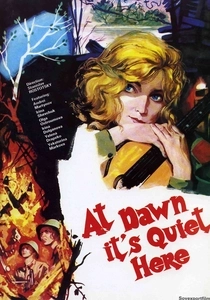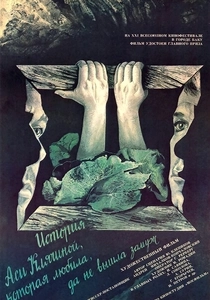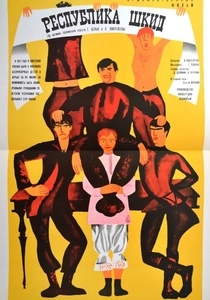- Welcome, or No Trespassing (1964)
- The Elusive Avengers (1966)
- The Dawns Here Are Quiet (1972)
- The Story of Asya Klyachina, Who Loved But Did Not Marry (1966)
- The Republic of SHKID (1966)
- The Key That Should Not Be Handed On (1976)
- The Adventures of Elektronik (1979)
- The Girls (1961)
- The Unusual Adventures of Karik and Valya (1987)
- The Mystery of the Third Planet (1981)
Soviet cinema has always had a unique way of capturing the essence of youth, reflecting the hopes, dreams, and challenges of growing up in a different era. These films not only entertain but also provide a window into the past, offering insights into the lives of young people in the Soviet Union. From tales of friendship and first love to stories of self-discovery and societal change, this collection of Soviet coming-of-age films is a treasure trove for anyone interested in the cultural and historical context of youth in the USSR.

Welcome, or No Trespassing (1964)
Description: A light-hearted comedy about a group of kids trying to sneak into a summer camp, this film captures the spirit of youthful rebellion and the quest for adventure, making it a beloved classic in Soviet cinema.
Fact: The film was directed by Elem Klimov, who later became known for his more serious and politically charged films like "Come and See."
 Watch Now
Watch Now 
The Elusive Avengers (1966)
Description: This adventure film follows a group of young partisans during the Russian Civil War, showcasing bravery, camaraderie, and the fight for justice, all through the eyes of youth.
Fact: It was one of the most popular Soviet films of its time, leading to two sequels and becoming a staple of Soviet children's cinema.
 Watch Now
Watch Now 
The Dawns Here Are Quiet (1972)
Description: While primarily a war film, it focuses on the lives of young female soldiers, exploring their youth, dreams, and the harsh realities of war, making it a poignant coming-of-age story set against a backdrop of conflict.
Fact: The film was based on a novel by Boris Vasilyev and was remade in 2015, highlighting its enduring appeal.
 Watch Now
Watch Now 
The Story of Asya Klyachina, Who Loved But Did Not Marry (1966)
Description: This film delves into the life of Asya, a young woman in a small village, exploring themes of love, societal expectations, and the quest for personal freedom, all through the lens of Soviet rural life.
Fact: The film was initially banned by Soviet censors but was later released in a heavily edited version.
 30 Days Free
30 Days Free 
The Republic of SHKID (1966)
Description: Based on a novel by Grigory Belykh and Leonid Panteleyev, this film tells the story of a group of street kids who form their own republic, exploring themes of freedom, authority, and the harsh realities of life for Soviet youth.
Fact: The film was shot in Leningrad, and some scenes were filmed in the actual SHKID school, which was a real institution for homeless children.
 30 Days Free
30 Days Free 
The Key That Should Not Be Handed On (1976)
Description: A story about a group of friends who find a mysterious key, leading them on an adventure that tests their bonds and teaches them about responsibility and trust.
Fact: The film was one of the first Soviet movies to explore the theme of youth subcultures and the underground music scene.
 30 Days Free
30 Days Free 
The Adventures of Elektronik (1979)
Description: This whimsical tale follows a robot boy, Elektronik, who looks exactly like a human boy, Seryozha. Their adventures highlight themes of identity, friendship, and the clash between technology and human emotions, making it a quintessential Soviet coming-of-age story.
Fact: The film was one of the first Soviet movies to use advanced special effects for its time, and it became a cultural phenomenon, spawning books, comics, and even a sequel.
 30 Days Free
30 Days Free 
The Girls (1961)
Description: A comedy-drama about a group of young women working at a textile factory, this film captures the essence of Soviet youth culture, focusing on friendship, work, and the pursuit of happiness.
Fact: The film was one of the first Soviet movies to openly discuss the topic of abortion, making it quite progressive for its time.
 30 Days Free
30 Days Free 
The Unusual Adventures of Karik and Valya (1987)
Description: This fantasy adventure film follows two children who shrink to the size of insects, exploring themes of friendship, courage, and the wonders of the natural world from a unique perspective.
Fact: The film was based on a popular children's book by Yan Larri, and its special effects were quite innovative for Soviet cinema.
 30 Days Free
30 Days Free 
The Mystery of the Third Planet (1981)
Description: While primarily a sci-fi adventure, this animated film captures the spirit of exploration and the curiosity of youth, as a young girl and her father embark on a space journey.
Fact: It was one of the first Soviet animated films to use computer graphics, and its popularity led to numerous re-releases and adaptations.
 30 Days Free
30 Days Free 








